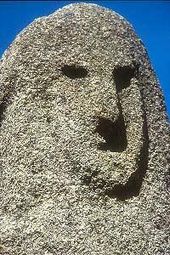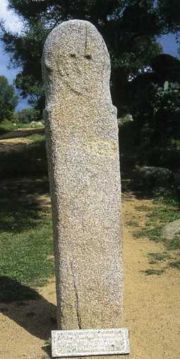
Filitosa
Encyclopedia



Corsica
Corsica is an island in the Mediterranean Sea. It is located west of Italy, southeast of the French mainland, and north of the island of Sardinia....
, France
France
The French Republic , The French Republic , The French Republic , (commonly known as France , is a unitary semi-presidential republic in Western Europe with several overseas territories and islands located on other continents and in the Indian, Pacific, and Atlantic oceans. Metropolitan France...
. The period of occupation spans from the end of the Neolithic
Neolithic
The Neolithic Age, Era, or Period, or New Stone Age, was a period in the development of human technology, beginning about 9500 BC in some parts of the Middle East, and later in other parts of the world. It is traditionally considered as the last part of the Stone Age...
era and the beginning of the Bronze Age
Bronze Age
The Bronze Age is a period characterized by the use of copper and its alloy bronze as the chief hard materials in the manufacture of some implements and weapons. Chronologically, it stands between the Stone Age and Iron Age...
, until around the Roman
Ancient Rome
Ancient Rome was a thriving civilization that grew on the Italian Peninsula as early as the 8th century BC. Located along the Mediterranean Sea and centered on the city of Rome, it expanded to one of the largest empires in the ancient world....
times in Corsica.
Location
The site is located on road D57, in the commune of SollacaroSollacaro
Sollacaro is a commune in the Corse-du-Sud department of France on the island of Corsica.-Geography:The village is located at 450 m of altitude in the Taravo valley, on the northwest side of a hill therefore there is no morning sun...
, north of Propriano
Propriano
Propriano is a commune in the Corse-du-Sud department of France on the island of Corsica.It is situated on the Valinco Gulf.-Population:-References:*...
, in the Corse-du-Sud
Corse-du-Sud
Corse-du-Sud is a French département composed of the southern part of the island of Corsica.- History :The department was formed on 15 September 1975, when the Corse department was divided into Haute-Corse and Corse-du-Sud...
département. It is located on a hill, overlooking the Taravo
Taravo
The Taravo is a river on the island of Corsica, France. Its source is in the mountainous middle of the island, southeast of Monte Renoso. It flows generally southwest, through Palneca, Cozzano and Guitera-les-Bains. It ends in the Mediterranean Sea in Serra-di-Ferro, west of Propriano. Its entire...
valley.
Site history and features
The site was discovered in 1946 by the owner of the land, Charles-Antoine Cesari. Systematic excavations started in 1954 by Roger GrosjeanRoger Grosjean
Roger Grosjean started his career as a French Air Force fighter pilot in France, England and North Africa. This involved a short stint as a Security Service double agent during World War II . He then became a very successful archeologist in Corsica. Grosjean was born on July 25, 1920, in...
. Finds of arrow heads and pottery date earliest inhabitation to 3300 BC. Around 1500 BC, 2-3 metre menhir
Menhir
A menhir is a large upright standing stone. Menhirs may be found singly as monoliths, or as part of a group of similar stones. Their size can vary considerably; but their shape is generally uneven and squared, often tapering towards the top...
s were erected. They have been carved with representations of human faces, armour and weapons. It is thought the menhirs may have been erected to ward off an invasion of a group of people called the Torréens (Torreans
Torrean civilization
The Torrean civilization was a civilization that developed in Corsica, in the area south of Ajaccio, during the second half of the II millennium BC. The characteristic building of this culture is the "Torre" , the Corsican version of the Sardinian "Nuraghe", although the torri were smaller and less...
). However this was unsuccessful: the menhirs were cast down, broken up and reused in some cases as building material by the Torréens. The Torréens built circular stone structures on the site, known as torri (or torre
Torre
Torre means tower in six Romance languages and may refer to:- Biology :* Muir-Torre syndrome, the inherited cancer syndrome...
), which may have been used as temples. The torri are remarkably well preserved.
In total, about twenty menhirs of various times were counted in Filitosa. They constitute approximately half of the total staff of these monuments in Corsica.
Layout
The site of Filitosa is approached down a track through an ancient oliveOlive
The olive , Olea europaea), is a species of a small tree in the family Oleaceae, native to the coastal areas of the eastern Mediterranean Basin as well as northern Iran at the south end of the Caspian Sea.Its fruit, also called the olive, is of major agricultural importance in the...
grove. The first monument to be seen is a rock overhang and surrounding wall. Then the visitor comes upon the central monument. Various hut platforms are all around, and the track leads a further 50m to the Western Monument or torri. From there, one can enjoy a view down the hill to a stone alignment of five megaliths, set around the base of a 2000 year old olive tree. Behind the olive tree is the quarry
Quarry
A quarry is a type of open-pit mine from which rock or minerals are extracted. Quarries are generally used for extracting building materials, such as dimension stone, construction aggregate, riprap, sand, and gravel. They are often collocated with concrete and asphalt plants due to the requirement...
, where the megaliths were extracted from.

